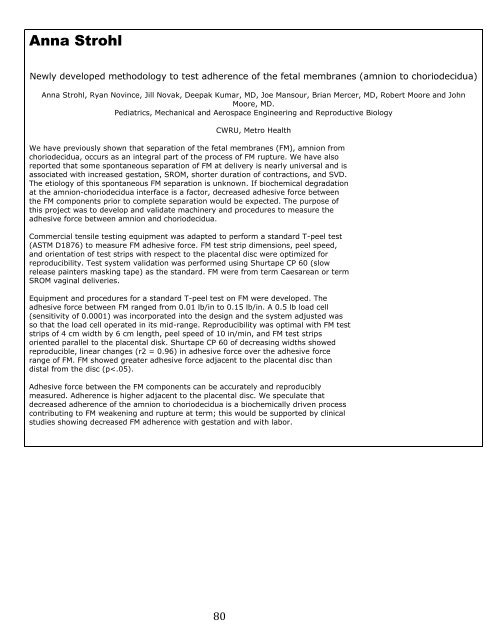student research day - Case Western Reserve University School of ...
student research day - Case Western Reserve University School of ...
student research day - Case Western Reserve University School of ...
Create successful ePaper yourself
Turn your PDF publications into a flip-book with our unique Google optimized e-Paper software.
Anna Strohl<br />
Newly developed methodology to test adherence <strong>of</strong> the fetal membranes (amnion to choriodecidua)<br />
Anna Strohl, Ryan Novince, Jill Novak, Deepak Kumar, MD, Joe Mansour, Brian Mercer, MD, Robert Moore and John<br />
Moore, MD.<br />
Pediatrics, Mechanical and Aerospace Engineering and Reproductive Biology<br />
CWRU, Metro Health<br />
We have previously shown that separation <strong>of</strong> the fetal membranes (FM), amnion from<br />
choriodecidua, occurs as an integral part <strong>of</strong> the process <strong>of</strong> FM rupture. We have also<br />
reported that some spontaneous separation <strong>of</strong> FM at delivery is nearly universal and is<br />
associated with increased gestation, SROM, shorter duration <strong>of</strong> contractions, and SVD.<br />
The etiology <strong>of</strong> this spontaneous FM separation is unknown. If biochemical degradation<br />
at the amnion-choriodecidua interface is a factor, decreased adhesive force between<br />
the FM components prior to complete separation would be expected. The purpose <strong>of</strong><br />
this project was to develop and validate machinery and procedures to measure the<br />
adhesive force between amnion and choriodecidua.<br />
Commercial tensile testing equipment was adapted to perform a standard T-peel test<br />
(ASTM D1876) to measure FM adhesive force. FM test strip dimensions, peel speed,<br />
and orientation <strong>of</strong> test strips with respect to the placental disc were optimized for<br />
reproducibility. Test system validation was performed using Shurtape CP 60 (slow<br />
release painters masking tape) as the standard. FM were from term Caesarean or term<br />
SROM vaginal deliveries.<br />
Equipment and procedures for a standard T-peel test on FM were developed. The<br />
adhesive force between FM ranged from 0.01 lb/in to 0.15 lb/in. A 0.5 lb load cell<br />
(sensitivity <strong>of</strong> 0.0001) was incorporated into the design and the system adjusted was<br />
so that the load cell operated in its mid-range. Reproducibility was optimal with FM test<br />
strips <strong>of</strong> 4 cm width by 6 cm length, peel speed <strong>of</strong> 10 in/min, and FM test strips<br />
oriented parallel to the placental disk. Shurtape CP 60 <strong>of</strong> decreasing widths showed<br />
reproducible, linear changes (r2 = 0.96) in adhesive force over the adhesive force<br />
range <strong>of</strong> FM. FM showed greater adhesive force adjacent to the placental disc than<br />
distal from the disc (p
















